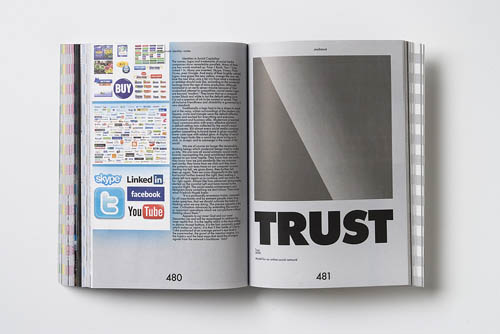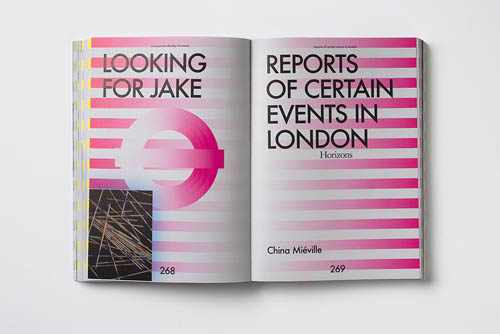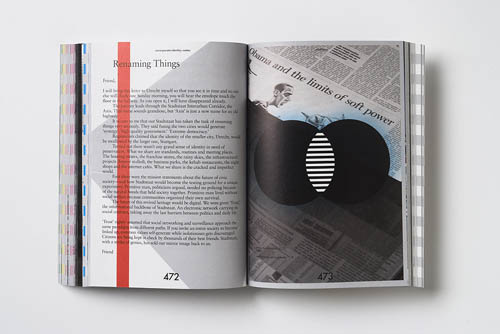Pretzel Logic: Surface as Critique
With so many man-hours devoted to brand-developing products, services, even states, it's high time such strategies were reverse-diagnosed. Metahaven and Marina Vishmidt's recent anthology Uncorporate Identity reveals the depths of the banality that surround us – review by Sam Jacob
Uncorporate Identity is a sprawl of a book whose scale and diversity of content is matched by the ambition of its assemblers, Metahaven with Marina Vishmidt, who describe themselves as 'a think tank focusing on design, visual identity and the political'. What that means, at least in the case of this book, is a sustained and multivalent investigation into the relationship between design and power, often using visual and design tactics themselves as the form of interrogation.

Image: Spread from Uncorporate Identity, 2010
In an era of post-functional design, an era we might call post-Wolff Olins (the firm that arguably invented modern brand consultancy, describing it as 'strategy made visible'), design has become increasingly dissipated. We've strayed far from the certainties that characterised design's relationship with, say, industry. Instead, design has developed a complex relationship with information. Post-Wolff Olins, design's effects are less obvious, less cause-and-effect. Increasingly design is involved in the construction of symbols and narratives for complex entities that themselves are only partially physical, only half real.
Uncorporate Identity looks through the other end of this telescope, giving us a fleeting glimpse of the machinery of branding. The book's research method is to turn the techniques of branding back onto themselves. The products of contemporary design culture - those seemingly straightforward logos, stamps, flags, currency and so on - are requisitioned as devices of critical engagement, as ways of prizing open the spectacles and banalities that cloud the operations of neoliberal power that they represent. Just as brand design has expanded the disciplinary field from the visual/physical to a multiple swarm of strategies, expertise, techniques and methodologies so, in turn, do Metahaven. Uncorporate Identity employs a kaleidoscopic range of media; alongside visual explorations we find, for example, fiction used as a technique to undo the narratives that swirl around contemporary forms of power in short stories by China Miéville and Keller Easterling. There's a logic to this strategy. It's a way of navigating the pretzel logic of postmodern, neoliberal culture by using a similarly pretzel shaped map.
But where to start either reading, reviewing or, I would imagine, writing this book? The subject itself is vast yet almost see-through and so slippery that you have to throw at least this much stuff at it before you can begin to make out its shape and size. Alongside those mainstays of cultural critique (essay, interview, discussion and so on) we flit between visual essays, fiction, cartoon strips and photography, all held together in a visual structure that preserves the sensation of fragmentary archive rather than book. It feels as though we've been dropped into a continuum of ongoing research. The status of its information - though printed - feels digital-raw, like fragments of an InDesign file, bits of JPG, PDF, text all in loose association, as though you could send to back, shift drag, delete to uncover more, to find other relations. It drags the book's centre of gravity closer to the process of assembly than the Command-P keystroke marking the final output of design's activities.

Image: Spread from Uncorporate Identity, 2010
This rawness and undigested, unresolved quality is combined with stuff that echoes tabloid graphic techniques. Imagine reading Heat in a parallel universe, where celebrity obsession is replaced with an interest in soft power, network culture and Ceau?escu's House of the People and you'd be getting close to the strange sensation of hyper close reading and restless flickability. So we switch from Pier Vittorio Aurelli in Brussels, to fragments of projects about Ryugyong Hotel Pyongyang, to the quasi-state of Sealand, to the visual legacies of 9/11, and, as Heat would say, 'Much, Much, More!'. Multiple voices, multiple subjects and multiple techniques compete. But somehow it develops a dialogue of momentum. We are shown the ways design constructs legitimacy through the abstracted symbols of state such as coins, banknotes, buildings and so on. Its examples are built on detailed scrutiny, taking us into areas of seeming trivia - how for example, the design of Euro notes features imaginary historic buildings - that expand into broad issues. Later, we read an amazing exploration of Death Metal logos chronicling their spiral into deliberate illegibility. These obscure graphic identities act as visual analogues of the genres sonic rejection of mainstream culture, but they also help us feel the edges of corporate design strategies.
The book's scale (608 pages!) still feels like it ends too soon. Uncorporate Identity displays a love of information in the manner of a conspiracy theorist. Near enough everything is here because it is all (potentially) significant and connected. Every detail is the tip of something much larger. Everything extrapolates, eventually, to something else. Conspiracy theory - rather than conspiracy itself - becomes a methodology to interrogate the vast operations of corporations and states. If conspiracy assumes there is something behind the visual paraphernalia of contemporary corporatism, Uncorporate Identity suggests that its smooth, banal surface is densely inscribed with codified narratives; that visual codes and the powerful ideological messages are contained in clear view within these seemingly blank spaces, scrawled across the transparent surfaces of communication design.
Post Wikileaks, we realise that our age of information is like a magic porridge pot. Once in operation it spews an unending stream of data into the world. With this as its context, design's role has evolved into a method of managing this formless gloop, of constructing legible identities behind which currents of radical abstractness swirl.

Image: Spread from Uncorporate Identity, 2010
Of course, Uncorporate Identity asks as much about the nature of design as the subjects it focuses on. It asks whether design is able to operate as a way of understanding as well as producing, if it can be used backwards to reverse engineering the contexts of its origins. In an appropriately inside-out manner, recalling the pretzel topography of the landscape it surveys, Metahaven echo Wally Olins definition of corporate identity - 'strategy made visible' - but with an entirely opposite intent.
Sam Jacob <sam AT fat.co.uk> is a director of the internationally recognised architecture practice FAT. He is Design Critic for Art Review and contributing editor for Icon. He is a Professor of architecture at Yale University and teaches at the Architectural Association, London. He writes and edits http://strangeharvest.com
Info
Metahaven (Daniel van der Velden, Vinca Kruk) with Marina Vishmidt, Uncorporate Identity , Lars Müller Publishers, 2010. ISBN 978-3037781692
Mute Books Orders
For Mute Books distribution contact Anagram Books
contact@anagrambooks.com
For online purchases visit anagrambooks.com






